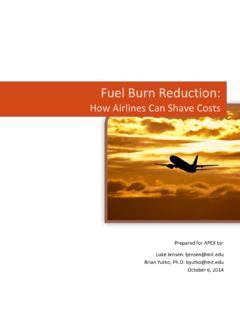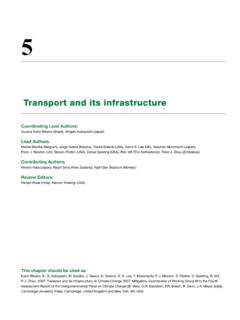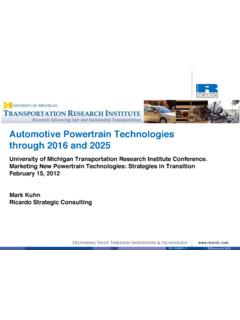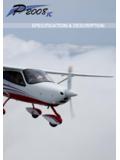Transcription of Simple and Low-Cost Aerodynamic Drag Reduction …
1 2003-01-3377. Simple and Low-Cost Aerodynamic drag Reduction Devices for Tractor-Trailer Trucks Richard M. Wood and Steven X. S. Bauer SOLUS Solutions and Technologies Copyright 2003 SAE International ABSTRACT concerns identifies a number of additional factors such as interference from other vehicles, atmospheric effects, Three Simple , low cost Aerodynamic drag Reduction and road conditions. All of these factors must be devices have been developed for application to the addressed when developing technologies to improve trailer of a tractor-trailer truck. The three devices have the fuel economy of heavy vehicles. undergone extensive operational testing where they have amassed over 85,000 miles of use.
2 These Shown in figure 2 is a schematic that depicts the impact technologies have shown a combined fuel savings of of several of these operational and environmental based 10% at an average speed of mph. This factors on the horsepower requirements of tractor-trailer improvement in fuel economy correlates to an equivalent trucks. The five factors listed at the top of figure 2 relate drag Reduction of approximately 30% with a to the uncertainty of the Aerodynamic load on a tractor- corresponding drag coefficient of Observations trailer truck. As noted in the figure, these factors all tend and anecdotal evidence from the test activity have to increase the Aerodynamic loading on a vehicle that has shown that the addition of these devices to the trailers been designed based upon the ideal case represented has not had a negative impact on either the operational in figure 1.
3 In an operational environment these factors utility of the trailers or the maintenance procedures and will vary continuously throughout the operational period requirements. and vary significantly with vehicle speed. There are also a number of geometric factors that INTRODUCTION influence the aerodynamics of tractor-trailer trucks. Shown in figure 3 is the Aerodynamic drag of tractor- An assessment of the energy usage of tractor-trailer trailer trucks due to changes in the flow field in the gap trucks shows that the primary resistance forces are drive- region between the tractor and trailer [8]. These data are train losses, rolling friction, and Aerodynamic drag , see for the ideal case of a vehicle operating at 60 mph in an figure 1 [1, 2, 3].
4 The chart of figure 1 shows that as undisturbed airflow. The data show that under ideal vehicle speed is increased the force required to conditions a tractor-trailer truck in which the tractor has overcome both Aerodynamic drag and rolling friction been designed to include Aerodynamic shaping and has increases. However, the rate of increase in Aerodynamic been fitted with roof and side fairings will have a drag drag with increasing vehicle speed is much greater than coefficient between and whereas a tractor-trailer that for rolling friction such that at approximately 50 mph truck that does not have Aerodynamic shaping and the force directed at overcoming Aerodynamic drag fairings will have a drag coefficient of to exceeds that required to overcome rolling friction.
5 The data of figure 3 can also be viewed as a summary of It should be noted that the graph shown in figure 1 is for the Aerodynamic drag Reduction efforts for tractor-trailer the ideal case in which the vehicle is moving through vehicles over the past 20 to 30 years [1, 3, 4, 7 - 9 - 18]. undisturbed air [1, 2, 3]. These data do not take into The trucking community has focused on reducing the account several operational and environmental factors Aerodynamic drag of the forward facing surfaces of both that can have a dominating effect on the Aerodynamic the tractor and trailer. Specifically, the Aerodynamic drag drag of tractor-trailer trucks [4, 5, 6, 7]. A more thorough has been reduced on the tractor forward facing surfaces accounting of all operational and environmental through Aerodynamic shaping of the tractor cab and the 1.
6 Aerodynamic drag has been reduced on the forward face ideal wind conditions. The schematic shows that the of the trailer by adding Aerodynamic fairings to the tractor dominant drag regions on a tractor-trailer truck are the in order to direct the flow away from the trailer front face. tractor front face, the gap region, and the trailer base. A. These efforts have produced reductions in the review of the drag on a tractor-trailer truck, operating Aerodynamic drag of 30%, for an operating speed of 60 under ideal conditions, indicates that 40% to 50% of the mph, with corresponding improvements in fuel economy Aerodynamic drag is attributed to the tractor and 60% to approaching 15%. However, these improvements have 50% is attributed to the trailer.
7 This variation in the drag not been consistently realized under operational distribution reflects the difference between a tractor with conditions [3, 4, 7, 12, 14, 19]. In an operational advanced Aerodynamic shaping, roof-spoiler, and side- environment, the unsteady and erratic flow that the fairings, which would have a tractor-to-trailer drag vehicle experiences degrades the effectiveness of distribution of 50% tractor drag and 50% trailer drag , these Aerodynamic devices. An assessment of the whereas a tractor with minimal Aerodynamic shaping and Aerodynamic drag in an operational environment a more simplistic Aerodynamic roof-spoiler and side- indicates that the Reduction in Aerodynamic drag at 60 fairings would have a tractor-to-trailer drag distribution of mph would be closer to 20%, which corresponds to a 40% tractor drag and 60% trailer drag .
8 However, the 10% improvement in fuel economy. benefit of the Aerodynamic fairing devices are not fully realized due to a variety of factors, most notably It is important to note that the drag reductions indicated crosswind effects, see figure 5. As depicted in figure 5. above would drop significantly with a decrease in vehicle the dominant drag areas on the vehicle are the same as speed. The relationship between Aerodynamic drag those discussed in figure 4. Under operational Reduction , fuel economy, and vehicle speed is depicted conditions, the distribution of Aerodynamic drag in table 1 [1, 20, 21]. between the tractor and trailer remains at 40% for the tractor to 60% for the trailer for all tractor-trailer trucks, independent of the conventional Aerodynamic Vehicle Aerodynamic drag enhancements.
9 These observations indicate that a significant portion of the Aerodynamic drag Reduction Speed Reduction to Increase gains made, with the addition of conventional (mph) Fuel Economy 1% Aerodynamic fairings, is reduced under operational 60 2% conditions. 40 3%. 20 6% All of the factors discussed above as well as numerous other issues should be viewed as constraints in the design of Aerodynamic technologies that are directed at Table 1. Relationship between Aerodynamic - drag improving the fuel economy of tractor-trailer trucks. Reduction and fuel economy improvement for Additionally, design activities directed at improving the tractor-trailer trucks. fuel efficiency of these vehicles must address vehicle operations, maintenance, safety, weight, and cost .
10 Other vehicle performance factors that must also be The data presented in table 1 highlight the difficulty in addressed are Aerodynamic loads, stability and handling, achieving meaningful fuel savings of 10% for a typical braking, splash and spray, and tire wear [2 - 7, 12, 19, tractor-trailer truck at an average speed below 60 mph. 20]. For an average speed of 40 mph the Aerodynamic drag would have to be reduced 30% to achieve a fuel economy improvement of 10%. The chart also shows Aerodynamic DESIGN. that if the average speed approaches 30 mph then it is nearly impossible to achieve a 10% improvement in fuel The objective of the Aerodynamic drag Reduction economy through Aerodynamic drag Reduction .




